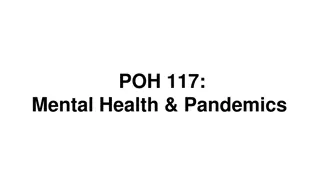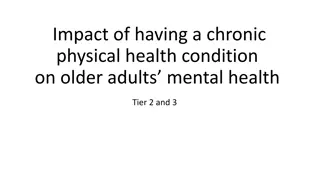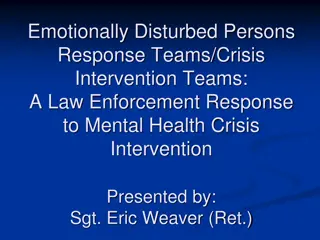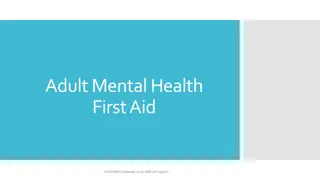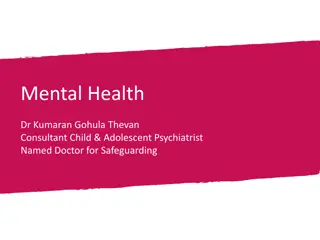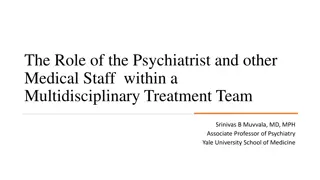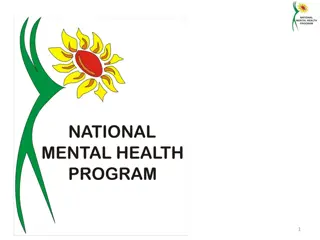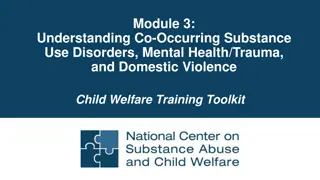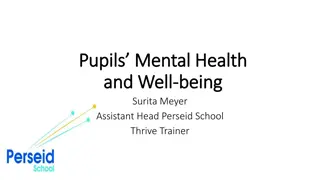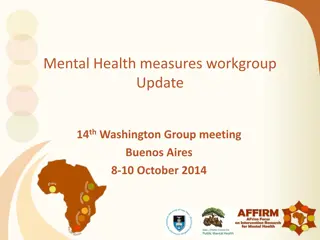Understanding Co-occurring Mental and Physical Health Conditions
Co-occurring mental and physical health disorders are prevalent and require an integrative multidisciplinary approach for effective assessment and treatment. This holistic approach helps address the complexity of managing multiple disorders in an integrated healthcare setting. Through a multi-directional model, the relationship between psychiatric disorders, substance abuse, and physical health conditions is explored. Common conditions like neurological disease, heart disease, and cancer often coincide with behavioral health conditions. Addressing mental health and substance use disorders together is crucial, as more than half of individuals with a drug use disorder also have a mental disorder. A comprehensive treatment framework focusing on symptom severity is recommended for managing co-occurring mental and substance abuse disorders.
Download Presentation

Please find below an Image/Link to download the presentation.
The content on the website is provided AS IS for your information and personal use only. It may not be sold, licensed, or shared on other websites without obtaining consent from the author. Download presentation by click this link. If you encounter any issues during the download, it is possible that the publisher has removed the file from their server.
E N D
Presentation Transcript
Medication and Integrated Healthcare Module 9 Marion Becker, PhD School of Social Work University of South Florida
Medication Issues in Integrated Healthcare Module 9: Outline Common comorbid medical and mental illnesses Prevalence of co-occurring mental health and substance use disorders Medication management in integrated healthcare Social workers role in medication management Medication monitoring Medication management strategies Medication side effects Diabetes and metabolic syndrome Medication assistance programs
Co-occurring Mental Health and Physical Health Conditions Co-occurring mental and physical health disorders are not only common, they are the norm 1 The high prevalence of co-occurring disorders means that social workers will be working with clients with multiple mental and physical health disorders regardless of their clinical practice setting Co-occurrence of mental and physical health disorders increases the complexity of assessment and treatment of each disorder which is best accomplished with an integrative multidisciplinary approach to effectively address all disorders present
Multi-directional Model of Co-occurring Disorders Psychiatric Disorder Substance Abuse Physical Health Conditions
Common Co-occurring Mental Health and Physical Health Conditions 2 Physical Condition All conditions Well Neurological Disease Heart Disease Chronic Lung Disease Cancer Arthritis % with BH condition 24.7% 17.5% 37.5% 34.6% 30.9% 30.3% 25.3%
Co-occurring Mental Health and Substance Abuse Disorders Mental health (MH) and substance use disorders (SUD) frequently co-occur. According to the National Co-morbidity Study Replication (NCS-R) data more than half (53%) of persons with a lifetime diagnosis of a drug use disorder also have a lifetime diagnosis of a mental disorder 3 A four-quadrant conceptual framework (based on symptom severity rather than diagnosis) has been set forth by several researchers to describe and treat co-occurring MH and SUD disorders. This integrated assessment and treatment approach is described in detail in the Treatment Improvement Protocol (TIP) available from the Center for Substance Abuse treatment (CSAT) (2005) 4
Costs Research shows that treating mental health and substance use disorders reduces costs of healthcare overall Shorter hospital stays Fewer costly tests Reduced mortality
National Co-Morbidity Study Replication (NCS-R) Social workers should be aware of the patterns and extent of psychiatric comorbidities that may exist Most authors quote the Kessler NCS-R Study data on co- occurring disorders. In that study all mental disorders were strongly related to drug dependence (DD) 1 Within the NCS-R study population, 78% had current co- occurring disorders (within 12 months). There was an 80% estimated prevalence for lifetime co- occurring mental health and substance use disorders.
NCS-R Results More than 17% of participants had a major depressive episode (MDE) in their lifetime. 10% had an episode of depression in the past 12 months. 14% had lifetime prevalence of alcohol dependence, and over 7% were dependent in past 12 months. 13% had lifetime prevalence of social phobia
NCS-R Results 27.7% reported two or more mental disorders and 17.3% had three or more Most common life-time disorders Major Depressive Disorder (16.6%) Alcohol abuse (13.2%) Social phobias (12.1%) Less than 20% of the study population accounted for 50% of the lifetime disorders 1
Co-occurring Trauma and PTSD Co-occurring substance use disorders, mental disorders and previous traumatic experience or PTSD has emerged as a major clinical, public health and research focus over the past decade because this combination of disorders is associated with poor physical health, poor treatment outcome, severe illness course, and high service utilization.5
Co-occurring Trauma and PTSD The NCS-R estimated the lifetime prevalence of PTSD among adult Americans to be 6.8%. Current past year PTSD prevalence was estimated at 3.5%.The lifetime prevalence of PTSD among men was 3.6% and among women was 9.7%. The twelve month prevalence was 1.8% among men and 5.2% among women.6 Persons with a history of traumatic experience and/or PTSD require (at a minimum) services that are trauma informed and when possible should have access to trauma specific services. 7
Persons with Co-occurring Mental Health and Substance Use Disorders frequently have Problems in regulating thought, affect and behavior. Poor self esteem Poor physical health Modest or low income Poor compliance with treatment recommendations and increased risk of prescription drug abuse
The Fastest Growing Drug Abuse Problem is Prescription Drug Abuse (PDA) PDA is defined as: use of a prescription drug other than in the manner or for the time period prescribed, or by a person for whom the drug was not prescribed (WHO 2007)
Prescription Drug Abuse (PDA) Nationally, prescription drug problems account for 5 to 20% of hospitalizations Estimated cost of healthcare for adults with drug events .. $77 billion for ambulatory care $8 billion for institutionalized persons including hospital inpatients. 8
Some Things Severe Mental Illness & Substance Dependence Have in Common Lifelong potential for relapse Loss of control Recovery despite on-going illness Denial, guilt, shame, depression Interventions need to be stage of change specific Adherence with treatment recommendations is often a major problem
Double Jeopardy The converging effects of ageism and sexism put older adults with co-occurring disorders at a particular disadvantage and increased risk of inadequate and inappropriate care for their MH and SUD
Medication Management in Integrated Healthcare (IC) Medication has been the mainstay of treatment for mental disorders. Medication management of persons with co- occurring medical, mental and substance use disorders is complicated and critical for treatment success Non-adherence with prescribed medication among psychiatric patients is a very common problem that can undermine treatment success 9 Successful medication management of psychiatric patients depends on the active involvement and collaboration of the client, social worker and the entire healthcare team
Medication Treatment Psychopharmacology is ever-changing. Existing medications are taken off the market and new medications are introduced at an ever-increasing rate making it imperative that social workers stay abreast of current and emerging information regarding mechanism of action, therapeutic dosing, safety and efficacy of psychiatric medications being prescribed. Their are four major classes of psychiatric medication Antipsychotics Antidepressants Mood Stabilizers Anxiolytics and sleeping pills
Medication Treatment The module assigned reading on pharmacologic competency provides detailed foundational information on specific psychiatric medications and their use. For additional information use the medication-related web-links provided in the course Toolkit to obtain the most current real-time information on specific psychiatric medications Remember that medication does not cure mental illness. It is used to control symptoms and is most effective when used in combination with psychotherapy
Alternative Approaches In addition to medication your client nay be using other approaches to treatment? Inquire about the use of: Herbs Vitamins Light Therapy Relaxation techniques Meditation Acupuncture Over the counter drugs Caffeine Alcohol Marijuana Any Other approaches Clients should be taught and encouraged to practice recovery lifestyle habits to improve overall health and wellness
Social Workers Role in Medication Management The social worker may know the client best and influences treatment decision making by helping the team decide on the most reasonable and effective medication strategy Social workers educate and support clients in adhering to recommended medication treatment and should regularly ask the client about side effects, and inquire about how they are actually taking their medication
Social Workers Role in Medication Management Social workers should know the client s medication history and what medications have been tried What medication has worked? What medication has not worked? What is the client willing to take? What can the client afford?
Medication Management Sensitivity and a trusting client provider relationship are key to successful medication management Client non-compliance is a frequent focus of practitioners attention but when clients stop taking medication it may be useful to think about the ways in which the healthcare system has fallen short and/or prescribed medication that has not met the client s expectation or led to the achievement of the client s treatment goals
Monitoring Medication Begin with what the prescriber and client is hoping the medication will do then develop a detailed, specific and concrete list of target symptoms and observable behaviors to be improved with medication Monitor the client s progress on the target symptoms. Focus on the target symptoms that bother the client most or interfere with functioning Use the monitoring information to make decisions on medication management. Before changing a medication investigate potential reasons the medication may not be having its desired effect
Monitoring Medication A variety of psychiatric symptom assessment tools (e.g. Brief Psychiatric Rating Scale, Behavior Symptom Index) are available (see the APA Handbook of Psychiatric Measures). Social workers can also use a specific target symptom list developed with the client and individualize a rating scale for any one or a combination of the following measures Daily symptom checklist Unwanted behavior check list Mood monitor Early warning checklist Intensity rating scale
Reasons medications may be ineffective Despite taking medication, social and psychological stress may be destabilizing the client Medication is not taken regularly or at all On-going substance use and abuse Unrecognized medical illness exacerbates or causes behavior symptoms Medication type or dose is ineffective for the particular client
Medication Management Strategies Wait and monitor progress Increase medication Decrease medication Switch medication Add a second medication Subtract a medication Continue the same prescription
Common Ways to Switch Medication Cross Taper: First medication is tapered down in stepwise fashion as the new medication is tapered up. For most medications, if possible, this is the preferred approach Crossover Switch: Start the new medication and increase to full dose. Then slowly decrease and stop the first medication. This is complicated but it is the safest way to switch and has the least risk of relapse. It ensures the patient always has a full therapeutic dose of medication. Stop and Start: Stop the first medication before the new medication is started. This approach has the highest risk of relapse. It is used when a rapid switch is needed because of intolerable side effects
Medication Side Effects All medications have risks, benefits, and the potential for side effects. Side effects that have been discussed will be less alarming than those that are unexpected. Therefore, social workers should know and discuss the known risks and potential side effects of the specific medications prescribed so clients can make an informed decision about what to take. Medication side effects should also influence the choice of medication. For example, for an underweight client medication that causes weight gain may be the good choice and that same medication would not be the preferred choice for an overweight client.
Diabetes and Metabolic Syndrome Type II Diabetes and metabolic syndrome are of particular concern for people with major mental illness. Type II Diabetes is the leading cause of blindness, leg amputation, and kidney failure. It is also associated with stroke and heart disease. 13% of people with schizophrenia have Type II diabetes. Although the biggest single risk factor is obesity some medications may be associated with diabetes apart from weight gain. 10 Many medications lead to weight gain but second generation (atypical) anti-psychotic medication is of particular concern.
Metabolic Syndrome Metabolic Syndrome is a set of risk factors that increase the chance that a person will develop diabetes and cardiovascular disease. Risk factors include: Abdominal obesity waist >40 inches men, >35 inches women Low HDL cholesterol < 40 mg/dl in men or < 50 mg/dl in women High triglycerides .150 mg/dl Fasting blood glucose .110mg/dl Elevated blood pressure >135/85mm Hg
Medication Management Social workers should be sure that anyone taking any antipsychotic medication, or anyone with schizophrenia should have regular screening that includes obtaining weight and waist circumference, blood pressure, and fasting blood tests. Family history of diabetes should also be obtained. If a client is taking psychiatric medication that can cause weight gain , talking about this side effect and recommending strategies to manage the problem is essential. It is important that the treatment team provide services to help manage the problem or link the client to a provider who can provide needed care. Concern about weight gain and diabetes should be one of the considerations in making medication decisions
Medication Assistance Programs What can be done when clients can t afford medication? Social workers should acquaint themselves with the many patient medication assistance programs available to low and no income clients (e.g. Patient Medication Assistance Inc. is one of the leaders in helping individuals receive free medications. In addition, most drug companies provide medication directly to patients who meet their program requirements.
Medication Assistance Programs A list of web-links to medication assistance programs is provided in the course Toolkit, They can be used to complete the assignment for this module. Although there are many medication assistance programs available, the eligibility criteria vary greatly so the client s characteristics must match the program eligibility criteria for the client to receive medication assistance.
References 1. Kessler, R.C., Berglund, P., Demler, O., Jin, R., Merikangas, K. & Walters. W. (2005). Lifetime prevalence and age-of-onset distributions of DSM-IV Disorders in the National Comorbidity Survey Replication. Archives of General Psychiatry 62(6) 593-602. 2. Tesson. M., Degenhardt, L., Proudfoot, H. (2005). How common is comorbidity, why does it occur? Austrian Psychologist 40 (2) 81-87. 3. Kessler, R.C., Chiu, W.T., Demler, O., Merikangas, K.R., & Walters, E.E. (2005). Prevalence, severity, and comorbidity of 12-month DSM-IV disorders in the National Comorbidity Survey Replication. Archives of General Psychiatry, 62(6): 617-627. 4. Center for Substance Abuse Treatment (2005). Substance abuse treatment for persons with co-occurring disorders (Treatment Improvement Protocol (TIP) Series 42 DHHS Publiation No SMA 05-3992) Rockville. MD. Substance Abuse Mental Health Services.
References 5. Center for Substance Abuse Treatment. (2006b). Screening, assessment, and treatment planning for persons with co-occurring disorders. COCE Overview Paper 2. DHHS Publication No. (SMA) 06-4164. Rockville, MD: Substance Abuse and Mental Health Services Administration, and Center for Mental Health Services. Kessler, R.C., Sonnega, A., Bromet, E. Hughes, M., & Nelson, C.B. (1995). Posttraumatic stress disorder in the National Comorbidity Survey. Archives of General Psychiatry, 52(12), 1048-1060. Weissbecker , I. & Clark, C. (2007) The Impact of Violence and Abuse on Women s Physical Health: Can Trauma-Informed Treatment Make a Difference? Journal OF Community Psychology, 35, (7) 909 923 Substance Abuse and Mental Health Services Administration, Results from the 2010 National Survey on Drug Use and Health: Summary of National Findings, NSDUH Series H-41, HHS Publication No. (SMA) 11-4658. Rockville, MD: Substance Abuse and Mental Health Services Administration, 2011. Awad, A. G., & Voruganti, L. N. (2004). New antipsychotics, compliance, quality of life, and subjective tolerability Are patients better off? Canadian Journal of Psychiatry, 49(5),297 302. 10. Llorente, M.D. & Urrula, V. (2006). Diabetes, Psychiatric Disorders, and the Metabolic Effects of Antipsychotic Medications. Clinical Diabetes 24 (1) 68-74 6. 7. 8. 9.




